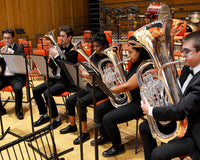A member of the Brass Family, the
French Horn is usually found in Orchestras, Wind and Military Bands. It has a wonderfully full and rich sound that is perfect to create emotional effects. This makes it a popular choice for film composers. With conical bores, rotary valves and large bell flares they are more complicated to manufacture than most brass instruments. As such they are generally more expensive. Commonly you can get a Single, Double or Compensating Horn. Keep reading for more details on this and more.
Single French Horns (F/Bb)
The most basic type of French Horn is the Single, so called as it only has one length of tubing and three rotary valves. They are available in F or Bb. The different pitch is down to the fundamental length of the instrument. The F horn (12 feet) is longer while the Bb (8 feet) is shorter, so sounds higher in pitch. There are different schools of thought about which instrument beginners should start on. Some teachers prefer F and some Bb. On the whole the Bb single Horn is more popular in the UK. The other big difference between the two is their natural harmonics, (how many/which notes can be played in open position.) The F horn can produce more notes than the Bb when none of the rotor valves are engaged. However, it is more difficult to produce/centre individual notes on the F horn as the potential options are closer together. The notes are easier to pitch on a Bb horn but the quality of sound is not quite as pure. Single horns are generally only used by beginners as they are the cheapest and lightest option. Many manufacturers now also produce compact singles. These are the same length but the tubing is wound much tighter making them easier for smaller children to hold. Eventually though, all French Horn players will be expected to use an instrument that incorporates both F & Bb tubing, aka the Double Horn.
Double French Horns
The ultimate instrument for any French Horn player is a Double Horn. These give you the best of both worlds with tuning and accuracy across the scale. As the name suggests, the Double Horn has two sets of tubing, one in F and the shorter one in Bb. There is an additional rotor valve that diverts the air flow from one 'side' of the instrument to the other. This gives the player the flexibility to choose when to use the F or Bb sides of the instrument. Double Horns are generally not suitable for younger players to start on as the two sets of tubing means they are much heavier. Furthermore the complex manufacturing process makes them far more expensive.
Compensating Double French Horns
Compensating Horns are a kind of 'half way house' between the Single and Double. They have one main set of Bb tubing and some additional tubing to change it into F. There is again an additional rotor valve but instead of simply switching between two sets of tubing it also routes the air through this extra tubing to effectively make it an F horn. This enables the instrument to be played like a Double horn but as there is less tubing they are cheaper to produce. Combined with the weight reduction these make them an ideal instrument for an advancing student. The downside of a Compensating is that it doesn't offer the level of secure tuning and natural harmonics available on a Full Double.
Triple French Horn
It is worth pointing out that there is also a Triple Horn which has yet another set of tubing to assist in the higher register. This is usually in the form of a high F or Eb section. These are few and far between. Only the best of the best need consider one of these.















